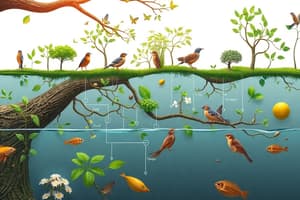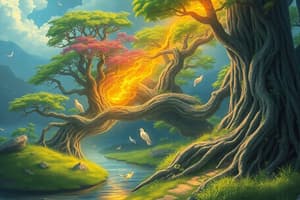Podcast
Questions and Answers
What is an ecosystem?
What is an ecosystem?
An ecosystem is an area that includes living organisms and non-living things that interact with each other.
What are examples of ecosystems?
What are examples of ecosystems?
- Ocean
- Rainforest
- Desert
- All of the above (correct)
Which of the following are producers?
Which of the following are producers?
- Animals
- Plants (correct)
- Fungi
- Humans
How do hawks obtain energy?
How do hawks obtain energy?
Hawks depend on plants for energy because they eat __________.
Hawks depend on plants for energy because they eat __________.
What role do decomposers play in an ecosystem?
What role do decomposers play in an ecosystem?
Which group cannot make their own food?
Which group cannot make their own food?
Predators are animals that are hunted and eaten by other animals.
Predators are animals that are hunted and eaten by other animals.
What is a food chain?
What is a food chain?
What is the primary source of energy for living organisms?
What is the primary source of energy for living organisms?
Which of the following is an example of a tertiary consumer?
Which of the following is an example of a tertiary consumer?
Which of the following is NOT a characteristic of consumers?
Which of the following is NOT a characteristic of consumers?
Flashcards are hidden until you start studying
Study Notes
Ecosystem Overview
- An ecosystem consists of living organisms (plants, animals, humans) and non-living components (air, soil, water) that interact within a specific area.
- Various ecosystems include oceans, rainforests, deserts, and tundras, providing essential resources like food, water, and shelter.
- Energy flow is crucial, moving from plants to animals and returning to the soil when organisms die.
Energy Flow Dynamics
- Hawks obtain energy by consuming other animals, including snakes, mice, fish, birds, squirrels, and rabbits; they rely indirectly on plants as food sources.
- Predators of hawks include eagles and other hawks.
- Decomposition returns energy to the soil, benefitting plant growth.
Nutrition and Energy Needs
- Living entities require food and oxygen for energy, facilitating various functions like movement and internal processes such as heartbeats and cognitive activities.
- Physical activities and hard work demand greater energy consumption.
Role of Sunlight
- The sun serves as the primary energy source for all living organisms, aiding in growth and essential life functions.
- Photosynthesis allows plants to convert sunlight into food by processing water and carbon dioxide into glucose.
Food Classification
- Organisms are classified into three groups based on their feeding mechanisms:
- Producers: Organisms, primarily plants, that synthesize their own food.
- Consumers: Organisms that rely on other living organisms for energy—subdivided into:
- Primary consumers: Eat plants (e.g., rabbits).
- Secondary consumers: Eat primary consumers (e.g., snakes).
- Tertiary consumers: Eat secondary consumers (e.g., eagles).
- Decomposers: Organisms, such as fungi, bacteria, worms, and millipedes, that break down dead organisms, enhancing soil fertility.
Food Chain Functionality
- A food chain illustrates energy transfer among organisms in a linear sequence, emphasizing the dependency on each other for food.
- Example chain:
- Producer: Plant
- Primary consumer: Mouse (which consumes the plant)
- Secondary consumer: Snake (which consumes the mouse)
- Tertiary consumer: Eagle (which consumes the snake)
- When the eagle dies, its energy returns to the soil, facilitating further plant growth.
Definitions
- Predator: An organism that hunts and consumes another organism.
- Prey: An organism that is hunted and consumed.
- Energy transfer occurs as both predator and prey interact within the food chain, underscoring their interdependence.
Food Web Concept
- A food web demonstrates the interconnectedness of several food chains, illustrating the complex relationships among different organisms and their energy exchanges.
Studying That Suits You
Use AI to generate personalized quizzes and flashcards to suit your learning preferences.




